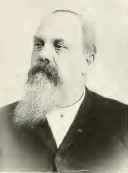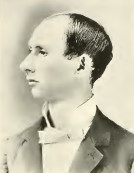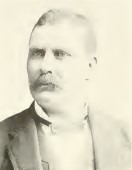|
Progressive Men of Minnesota
Minneapolis Journal
1897
 MAJOR ERFORD
ANDRE CAMPBELL, president of the
State Bank of Winthrop, is one of the Sibley County
pioneers and perhaps the most prominent business man in
that part of the state. He is a native of New York
state. His father, Zuriel Campbell, who was of Scotch
descent, emigrated from Courtland County, New York, to
Wisconsin, in 1846, and located in Dane County. His son
Andre was then ten years old, having been born on April
4, 1836. MAJOR ERFORD
ANDRE CAMPBELL, president of the
State Bank of Winthrop, is one of the Sibley County
pioneers and perhaps the most prominent business man in
that part of the state. He is a native of New York
state. His father, Zuriel Campbell, who was of Scotch
descent, emigrated from Courtland County, New York, to
Wisconsin, in 1846, and located in Dane County. His son
Andre was then ten years old, having been born on April
4, 1836.
As a boy Andre remained on
the farm with his parents. When the war broke out he
enlisted in the Seventh Regiment of Wisconsin volunteers
and was attached to the famous Iron Brigade of the Army
of the Potomac. Major Campbell participated in the
famous campaigns of the Army of the Potomac from August,
1862, to July 1864. He was in the battles before
Washington in the army commanded by Maj. Gen. John Pope,
including those of Gainesville and the second Bull
Run. While
in front of Petersburg in the battle of July 30, 1864,
he was wounded and by reason of the disability caused by
these wounds was honorably discharged from service on
November 22, of the same year. Major Campbell came to
Minnesota and settled in Sibley County in the town of
Transit in March, 1865. In the following November he was
married to Miss Jane O’Brien, of Durand Illinois. They
have one child. Miss Anna A. H. Campbell, who graduated
from Hamline University in the class of 1893.
In 1881 Mr. Campbell removed
into the village of Winthrop and entered the real
estate, insurance and loan business. Since that time he
has been prominently identified with the business
interests of the section and has been uniformly
prosperous. His interests have constantly broadened. In
1888 he organized with others the State Bank of Winthrop
and became its first president; he has held that
position ever since. In 1895 he assisted in organizing
the Minneapolis, New Ulm and Southwestern Railroad
Company, and was made its president. He has milling
interests and still operates a large farm. During his
business career he was for a time, agent of the Winona
& St. Peter Land Company, and in that capacity sold
over forty-five thousand acres of land in his part of
the state. Maj. Campbell has not been a politician in
the sense of being an office seeker. But the prominent
businessman in a western town can hardly escape the
cares and duties of public service. He was the first
postmaster of Winthrop, has been elected mayor for three
successive terms and is president of the Board of
Education of the Independent School District of
Winthrop.
He has always been a Republican.
For six years past he has been chairman of the county
committee of his party. Maj. Campbell is a member of the
Minnesota Commandery of the Military Order of the Loyal
Legion, and also of Gen. Hancock Post of the Grand Army
of the Republic. He belongs to the St. John’s Chapter of
Royal Arch Masons, of Minneapolis, and is a member of
Eagle City Lodge, No. 123, I. O. O. F., of Winthrop, and
of Winthrop Lodge, Knights of Pythias. Though not a
church member, he attends the Congregational church in
his town. The pleasant home of the Campbells is located
at the corner of Carver and Fourth Streets, in Winthrop.
A modern and spacious house is supplemented by large
grounds, gardens and well-filled stables. It is known as
one of the pleasantest homes in the
county.
 EDWARD H. HUEBNER mayor of Winthrop, Sibley
County, is one of the progressive young Republican
politicians of central Minnesota, and a leading member
of the bar in that part of the state. Mr. Huebner is
of foreign descent, as his name indicates. His father,
who is not now living, was Conrad Huebner, a native of
Austria. His mother, who is also dead, was born in
Switzerland.
Mr. Huebner was born in Chicago, January 23,
1865. During the same year his parents moved to New Ulm,
Minnesota, and Edward grew up there, attending the
common schools of the town and later the State Normal
School at Mankato, from which he graduated in 1886. Soon
after he entered the office of John Lind, at New Ulm,
and commenced reading law. He was admitted to practice
in 1888. After a year with Mr. Lind he removed to Winthrop and opened an office
of his own. EDWARD H. HUEBNER mayor of Winthrop, Sibley
County, is one of the progressive young Republican
politicians of central Minnesota, and a leading member
of the bar in that part of the state. Mr. Huebner is
of foreign descent, as his name indicates. His father,
who is not now living, was Conrad Huebner, a native of
Austria. His mother, who is also dead, was born in
Switzerland.
Mr. Huebner was born in Chicago, January 23,
1865. During the same year his parents moved to New Ulm,
Minnesota, and Edward grew up there, attending the
common schools of the town and later the State Normal
School at Mankato, from which he graduated in 1886. Soon
after he entered the office of John Lind, at New Ulm,
and commenced reading law. He was admitted to practice
in 1888. After a year with Mr. Lind he removed to Winthrop and opened an office
of his own.
He at once took an active part in
the politics of the county, and in 1890 was nominated
for the office of county attorney, on the Republican
ticket. The county had always been democratic by three
hundred majority but Mr. Huebner accepted the nomination
and came within three votes of defeating his opponent.
This was considered a remarkable run as the opposition
candidate had two years before won over two other
candidates by a plurality of nearly five hundred votes.
In 1892 Mr. Huebner was again nominated and was elected,
being the first Republican to be elected to the office
of county attorney in Sibley County. He was re-elected
in 1894, and in March of the same year was elected mayor
of Winthrop. He declined re-nomination for the mayoralty
in 1895, but was induced to accept in 1896 and was again
elected. Among the secret societies to which Mr. Huebner
belongs are the Knights of Pythias and the Odd Fellows.
He occupies the office of Chancellor Commander of the
local lodge of Knights of Pythias. He is a member of the
Congregational church. Though now thirty-one years of
age. Mr. Huebner is a
bachelor.
 GEORGE
ALLISON MACKENZIE. The ancestry of George A. MacKenzie,
of Gaylord, Minnesota, were Scotchmen as far back as the
line can be traced, for he comes of that old highland
Scotch family of MacKenzies which numbers among its
members many notable characters. Prominent in the family
have been a long line of Earls of Seaforth; Sir
Alexander MacKenzie, who discovered the great river in
North America, which bears his name: Sir George
MacKenzie, the famous Scotch lawyer; Henry MacKenzie,
the Scotch author, and Sir Morrell MacKenzie, the noted
physician, and many others. GEORGE
ALLISON MACKENZIE. The ancestry of George A. MacKenzie,
of Gaylord, Minnesota, were Scotchmen as far back as the
line can be traced, for he comes of that old highland
Scotch family of MacKenzies which numbers among its
members many notable characters. Prominent in the family
have been a long line of Earls of Seaforth; Sir
Alexander MacKenzie, who discovered the great river in
North America, which bears his name: Sir George
MacKenzie, the famous Scotch lawyer; Henry MacKenzie,
the Scotch author, and Sir Morrell MacKenzie, the noted
physician, and many others.
Mr. MacKenzie’s father,
Malcom MacKenzie, was born in the Isle of Skye, in 1834,
and emigrated to Prince Edward Island. When ten years
old he came to the United States, and later settled in
Chicago, where he engaged in business for a number of
years. In 1868 he came to Minnesota, settling in Le
Sueur County, which county he represented in the
Minnesota legislature of 1877. His wife was Miss Annie
Kerr, a daughter of Charles Kerr, one of the early
settlers of northern Illinois and, like Mr. MacKenzie,
was of an old Scotch family.
George A. MacKenzie was born
at Roscoe, Illinois, on March 14, 1857. He came with the
family to Minnesota in 1868, and lived near Rochester,
where he attended school. Moving to Le Sueur County, he
taught school for seven years, and at the same time
commenced reading law. For a time he was under the
instruction of M. R. Everet, of Waterville,
Minnesota.
On June 8, 1886, he was admitted to the bar at
Owatonna, before the Hon. Thomas Buckham, Judge of the
Fifth Judicial District, and was complimented for the
excellent examination which he passed. During his ten
years’ practice Mr. MacKenzie has been attorney in a
number of important cases, one of which settled the
important question of law in this state relative to the
validity of the incorporation of villages attempted
under the law of 1883. (This is known as the case of
State of Minnesota vs. Spaude). He has
been admitted to practice in the state courts of
Minnesota, Montana and Washington, and in several of the
United States District Circuit Courts. Since he moved to
Gaylord, Mr. MacKenzie has been for five years
corporation attorney for the village and a bright public
speaker. He has been much in demand during the political
campaigns for the past ten years, and has done much
speaking in behalf of the Republican party. During this
time he has attended as a delegate nearly every
Republican state convention held in Minnesota.
Mr. MacKenzie is an
enthusiastic sportsman, and has hunted big game in
nearly all parts of the northwest. For the past five
years he has been secretary of the “M. C. K. Hunting
Club,” an organization of over forty members. It
controls some of the best shooting posts in Southern
Minnesota.
During one of Mr. MacKenzie’s hunting trips he
was the guest of the famous Marquis De Mores, at Medora,
on the Little Missouri river. On January 10,
1879, Mr. MacKenzie was married at Waterville,
Minnesota, to Miss Mattie Oblinger. They have three
children, Ethlyn Genevieve, now fifteen years of age;
Claud Hillel, and George, Jr., aged respectively
thirteen and seven years. Mr. MacKenzie is now and has
been for about six years, a member of the school board
of Gaylord. For several years he has been engaged with
others in an attempt to move the county seat of Sibley
County to his town, and he still expects to be
successful in this project.
 PETER P. QUIST. After almost a lifetime of
military service in the old country, the hardships of a
pioneer on the plains of Minnesota must seem quite
trivial.
Peter N. Quist, father of the subject of this
sketch, came to America in 1865, after having served
twenty-six years in the army of Sweden. He took up a
homestead in Nicollet County, then far on the frontier.
In fact there was no lumber supply nearer than
Minneapolis, and lumber for the house which the
immigrant put up was hauled from Minneapolis. It was on
this farm that young Peter saw the first of Minnesota
life. He was born August 18, 1854, in Rinkaby, Sweden,
and was, consequently, eleven years of age when his
parents came to America. PETER P. QUIST. After almost a lifetime of
military service in the old country, the hardships of a
pioneer on the plains of Minnesota must seem quite
trivial.
Peter N. Quist, father of the subject of this
sketch, came to America in 1865, after having served
twenty-six years in the army of Sweden. He took up a
homestead in Nicollet County, then far on the frontier.
In fact there was no lumber supply nearer than
Minneapolis, and lumber for the house which the
immigrant put up was hauled from Minneapolis. It was on
this farm that young Peter saw the first of Minnesota
life. He was born August 18, 1854, in Rinkaby, Sweden,
and was, consequently, eleven years of age when his
parents came to America.
He attended the public
schools in St. Peter, and also St. Ausgari Academy at
Carver, Minnesota, and in the intervals of school life
worked on the farm with his father. At the age of
twenty-one he left the farm and learned the hardware and
farm machinery business. There are seven brothers in the
Quist family, and all are living in this country and
occupying positions where they command the respect of
their fellow citizens. The oldest
brother, Nels, came to America before his parents, and
settled in Nicollet County. Andrew, the
second brother, came over in 1857, and when the
rebellion broke out enlisted in the First Minnesota
Volunteer Infantry, and served during the entire war in
that famous regiment. He was wounded
in the battle of Gettysburg. He now lives in Grafton,
North Dakota. The third brother was Olof, who became the
founder and editor of Skordemannen, the only Swedish
agricultural paper in the United States. He was also the
first postmaster of New Sweden. Another brother is the
Rev. H. P. Quist, who was ordained at Philadelphia in
1876, and is a member of the Augustana synod of the
Swedish Lutheran church. J. P. Quist is in business with
Peter at Winthrop, and the youngest brother is living at
New Sweden, where he is postmaster. The father of this
large family died in 1891, aged eighty years. Their
mother is still living, and is now eighty-three years
old.
In 1882 Peter Quist located
at the then new town of Winthrop, Sibley County. It was
at that time the terminus of the Pacific division of the
M. & St. L. railway, and a promising place. Mr.
Quist opened a hardware and farm machinery store under
the name of Quist Brothers, associating with himself in
the business his brother, J. P., and C. J. Larson,
afterwards state senator. The business has
prospered.
There have been a number of changes, and the
concern is now known as P. P. Quist & Co. Mr. Quist
was appointed postmaster in 1883 and served for ten
years, giving way in 1893, when the Democracy had a man
for the place.
Mr. Quist has always been a
Republican. He has taken much interest in party affairs,
has been a member of many of the conventions in the
county and congressional district, and has represented
the county in state conventions. He is a member of the
Sibley County Republican committee, a town trustee, a
member of the school board, vice president of the
Winthrop board of Trade, director in the State Bank of
Winthrop and a director in the Scandinavian Relief
Association of Red Wing.
When the Swedish Lutheran church at
Winthrop was formed he became one of the incorporators
and has been its treasurer for a number of years. On
February 5, 1881, Mr. Quist married Miss Emma M. Falk,
of Red Wing, who was a teacher in the schools of Goodhue
County. They have six children, Ida, Hugo, Chester,
Mauritz, Walter and Lydia.
The information
on Trails to the Past © Copyright
may be used in personal family history research,
with source citation. The pages in entirety may not be
duplicated for publication in any fashion without the
permission of the owner. Commercial use of any material
on this site is not permitted. Please respect the
wishes of those who have contributed their time and
efforts to make this free site possible.~Thank
you! |



